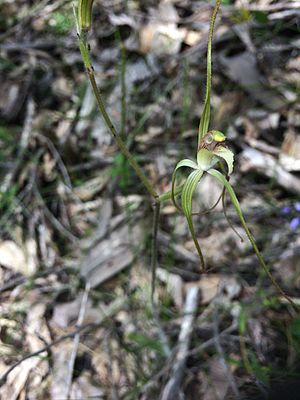Frail spider orchid facts for kids
Quick facts for kids Frail spider orchid |
|
|---|---|
 |
|
| Conservation status | |
| Scientific classification |
|
| Kingdom: | Plantae |
| Clade: | Tracheophytes |
| Clade: | Angiosperms |
| Clade: | Monocots |
| Order: | Asparagales |
| Family: | Orchidaceae |
| Subfamily: | Orchidoideae |
| Tribe: | Diurideae |
| Genus: | Caladenia |
| Species: |
C. uliginosa
|
| Subspecies: |
C. u. subsp. patulens
|
| Trinomial name | |
| Caladenia uliginosa subsp. patulens Hopper & A.P.Br.
|
|
| Synonyms | |
|
Arachnorchis uliginosa subsp. patulens (Hopper & A.P.Br.) D.L.Jones & M.A.Clem. |
|
The frail spider orchid (scientific name: Caladenia uliginosa subspecies patulens) is a special type of orchid found only in the south-west part of Western Australia. It's known for its unique greenish-cream flowers that look a bit like a spider. This orchid has a single hairy leaf and its flowers have a white part called a labellum that sticks out.
Contents
What the Frail Spider Orchid Looks Like
The frail spider orchid is a ground-dwelling plant. It's a perennial herb, meaning it lives for more than two years. It also loses its leaves each year (it's deciduous). This plant grows from an underground tuber, which is like a small storage organ.
Leaves and Flowers
- Each orchid has one straight, hairy leaf. This leaf is usually about 12 to 18 centimeters (5 to 7 inches) long and 6 to 10 millimeters (about 0.2 to 0.4 inches) wide.
- The plant grows a tall stem, about 20 to 35 centimeters (8 to 14 inches) high.
- On this stem, you'll find up to three greenish-cream flowers. Each flower is quite large, about 8 to 10 centimeters (3 to 4 inches) long and 4 to 6 centimeters (1.5 to 2.5 inches) wide.
Flower Parts
The parts of the flower that look like petals are called sepals and petals. They have thin, brownish, thread-like tips.
- The top sepal stands upright. It's about 4.5 to 10 centimeters long and 2 millimeters wide.
- The side sepals curve downwards. They are also 4.5 to 10 centimeters long but a bit wider, about 4 to 5 millimeters.
- The petals are similar to the side sepals, curving downwards. They are 3.5 to 8 centimeters long and about 3 millimeters wide.
The Labellum
The labellum is a special lip-like part of the orchid flower.
- The frail spider orchid's labellum is 1.4 to 2.2 centimeters long and 0.7 to 1 centimeter wide.
- It sticks out forward and has a white tip.
- The sides of the labellum have short, thin, pale red teeth.
- Its tip curves downwards.
- There are four rows of pale red bumps, called calli, along the center of the labellum.
Flowering Time
You can see the frail spider orchid in bloom from September to early October.
How it Got its Name
The scientific name for this orchid is Caladenia uliginosa subspecies patulens.
- The main species, Caladenia uliginosa, was first described in 1984 by a botanist named Alex George. This description was published in a science journal called Nuytsia.
- Later, in 2001, two other botanists, Stephen Hopper and Andrew Phillip Brown, described three different types (subspecies) of Caladenia uliginosa. One of these was subspecies patulens.
- They published their findings in Nuytsia as well, based on a plant found near Harvey.
Meaning of "Patulens"
The name patulens comes from the Latin word patulus. This word means "spread out" or "open." It refers to how the side sepals and petals of this particular orchid subspecies are more spread out compared to another subspecies, uliginosa.
Where the Frail Spider Orchid Lives
The frail spider orchid is found in a specific area of Western Australia. You can find it between the towns of Harvey and Nannup.
- It grows in areas known as the Jarrah Forest and the Swan Coastal Plain.
- These orchids usually prefer to grow among thick shrubs in woodlands and forests.
Protecting the Frail Spider Orchid
The Government of Western Australia's Department of Parks and Wildlife has classified Caladenia uliginosa subspecies patulens as "Priority One".
- This means the orchid is known to exist in only a few places.
- Because it's found in so few spots, these locations are potentially at risk. This classification helps make sure efforts are made to protect this special plant.


